This post may contain affiliate links. Please read our disclosure policy.
You will absolutely love this Asian bakery-style super soft and fluffy orange chiffon cake made with freshly squeezed orange juice and orange zest. All the tips you need to know with step-by-step photos and a video tutorial.

Chiffon cake gets lots of love in our house. The very first chiffon cake I’ve ever baked was this Soft and Fluffy Pandan Chiffon Cake. Ever since that, there’s no looking back and I can’t stop baking chiffon cake 🙂 My daughter loves its super soft and fluffy texture. It’s funny that chiffon cake comes from the U.S., but I don’t think it’s that popular here at all, compared to angel food cake (using egg whites only). Chiffon cake is very popular in Asia. Orange chiffon cake is one of the popular flavors besides pandan chiffon cake.

WHY YOU’LL LIKE THIS ORANGE CHIFFON CAKE
1. Super soft and fluffy
My daughter loves chiffon cake for its softness and fluffiness. She said “It’s like a soft pillow that bounces back LOL”
2. No artificial flavoring
You are welcome to use additional orange extract, but I think the orange juice and zest are enough to give that nice aroma without overpowering
TYPE OF ORANGES TO USE
If you can use juicing oranges like Valencia (first choice) or Mandarin oranges (Tangerine or Clementine) would be the best. You can juice them the day before and they won’t be bitter.
I have to use navel oranges because that’s what available and if you use navel oranges, juice them the same day you are going to use it as they will turn bitter when you keep it overnight.

I wrote in much more details about basic chiffon cake in this soft fluffy pandan chiffon cake if you are interested to read more about it.
HOW TO MAKE REALLY SOFT AND FLUFFY ORANGE CHIFFON CAKE
1. Squeeze some orange juice and grate some orange zest
Wash the oranges with clean water and pat them dry. Use a sharp grater to grate the rind of the oranges to get some orange zest. Be careful not to grate the bitter white part
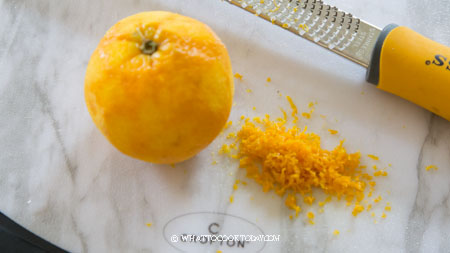
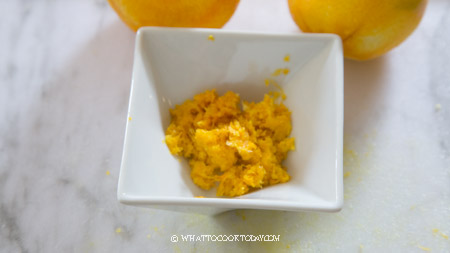
Squeeze some orange juice out to get the amount you need for the recipe
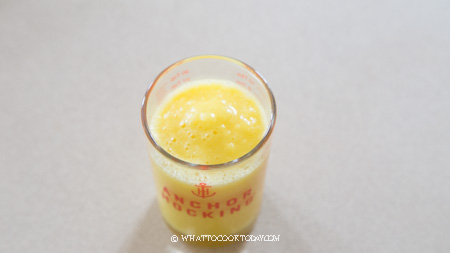
2. Mixing the thick batter
Whisk the egg yolks with sugar and cooking oil, then add orange juice and orange zest
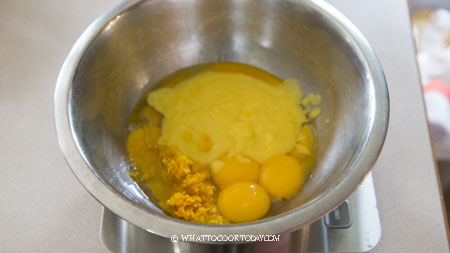
Mix the flour, salt, and baking powder and whisk to mix. Gradually add the cake flour mixture to the egg batter while mixing OR if you have sieve or flour sifter, sift in the cake flour mixture into the batter, there will be no lumps when you do this
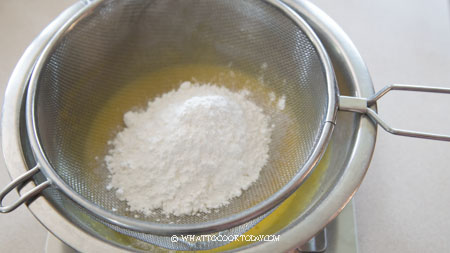
Mix until smooth and no lumps, try not to overmix it too. There will be tiny lumps from the orange zest, no worries
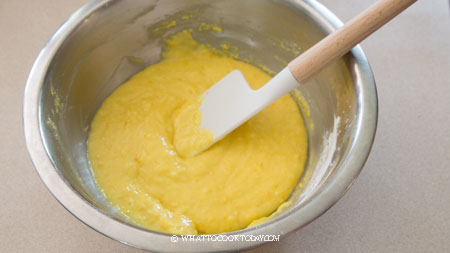
3. Whipping the meringue
Preheat your oven to 330 F (165 C). Place the oven rack 3rd from the top. For convection oven, lower the temperature by 20 F (15 C)
Place the egg whites in a clean bowl. You will have trouble whipping your meringue if there’s a trace of grease in your utensils or bowls. Beat the egg whites on medium speed until frothy
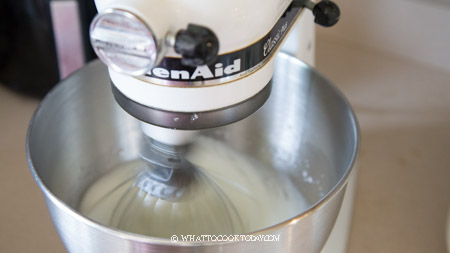
Add cream of tartar or acid of choice and whip until it turns whitish. Gradually add the sugar in 3-4 batches as you beat
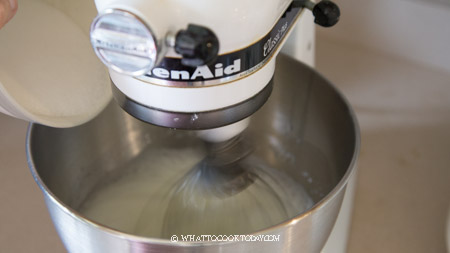
Whip until you get a stiff peak. You will know you get to the stiff peak when you hold your whisk up and your meringue holds its shape
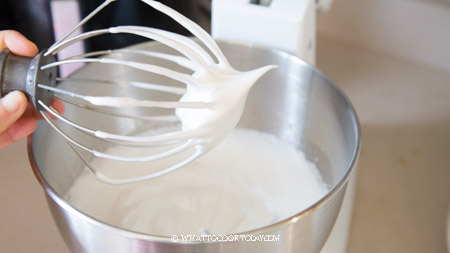
4. Fold in meringue into the thick batter
Gently fold in 1/4 of the meringue into the thick batter. Using a rubber spatula, swipe from the side and gently fold over to mix and then continue. Repeat this motion several rounds. Continue on with second 1/4 of the meringue again to mix
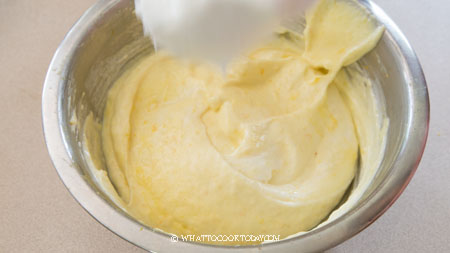
Continue to do this until you are done with the meringue and the batter and meringue are nicely mixed
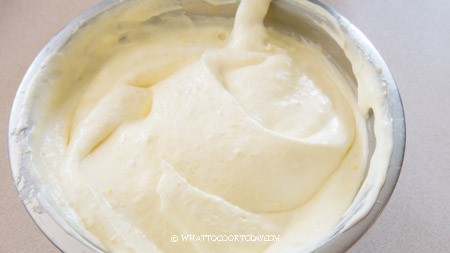
DO NOT grease your chiffon pan. The cake needs to cling to the pan to rise. You can use a toothpick to pop any air bubbles you see and gently drop the cake pan from about 10 cm height on the counter 2-3 times. This helps to minimize shrinkage after baking
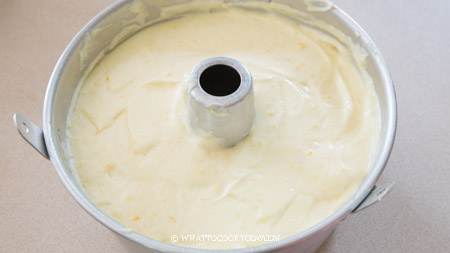
5. Bake the cake
Put the chiffon pan in the middle rack and let it bake for 40-45 minutes for 6-inch at 330 F (165 C) for conventional oven, 45-50 minutes for 7-inch, 50-55 minutes for 8 inch, 55-60 minutes for 9 inch, 60-65 minutes for 10 inch. The time is just for a reference. Your oven may need less or more time to bake. For convection oven, lower the temperature by 20 F (15 C)
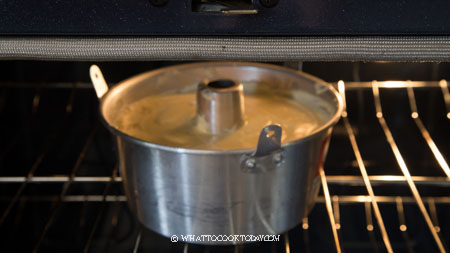
Don’t be alarmed if your cake has some cracks on top. What you are looking at will become the bottom of your cake. I find that baking at this temperature in my oven prevents the cake from cracking
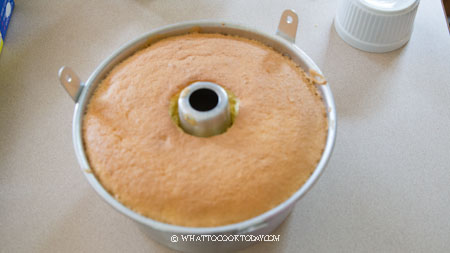
6. Invert to cool down
Once out of the oven, carefully invert the pan upside down. Your chiffon pan may have the little stands for you to invert, but I find it not high enough. I use a glass jar and set the inverted pan on top of the jar and let it cool down completely. Please don’t be tempted to remove from the pan if it’s still warm. It takes about one to two hours to cool down completely
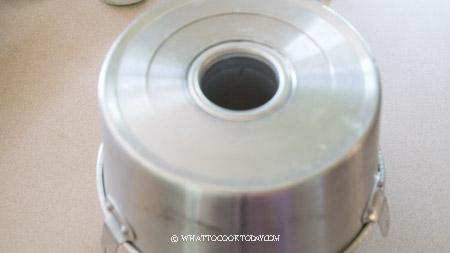
Once it’s cool down completely, use a spatula knife to run through the edge of the cake to help release the cake
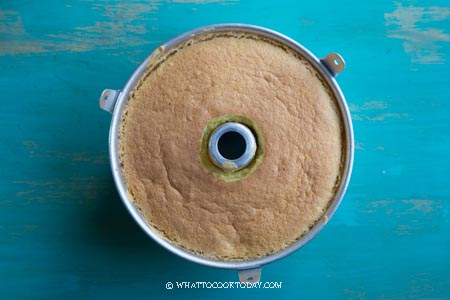
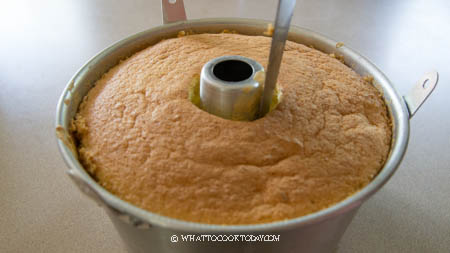
Gently push the base of the pan down. Use the knife again to run through the top of the cake to help release it from the base of the pan
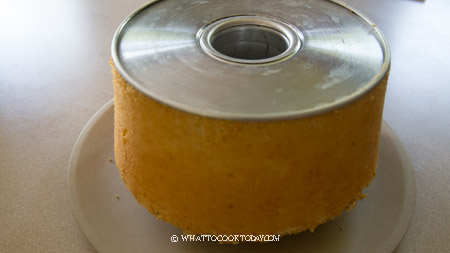
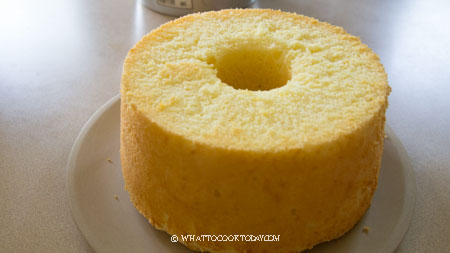
7. Simple decoration (optional)
Arrange some thinly sliced oranges. Dust with some confectioners sugar and serve
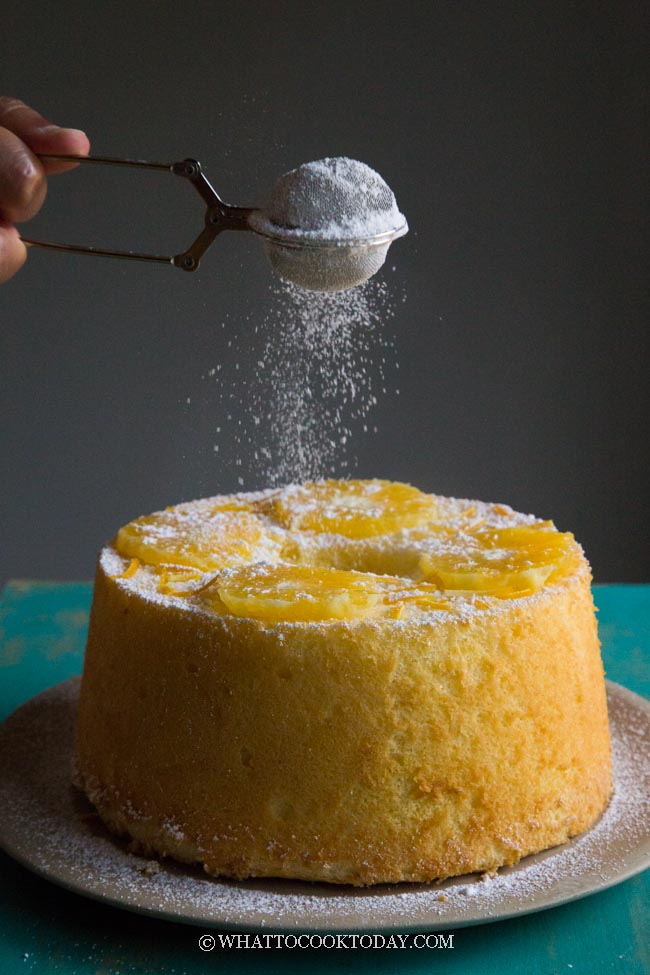
TIPS TO MAKE GOOD ORANGE CHIFFON CAKE
1. Make sure the eggs and orange juice are at room temperature
2. Use freshly squeezed orange juice if possible
3. Try the orange juice (especially if you squeeze your own OJ). Every orange is different. Some may be sweet some may be not. So you may need to adjust the amount of sugar
4. Use a sharp grater to get the orange zest. Don’t grate into the white part of the rind because it is bitter
5. I highly recommend using cake flour. It makes a huge difference compared to using regular all-purpose flour. You can always make your own cake flour if you don’t have any (details in the notes on the recipe card)
6. Do not decrease the amount of oil in the recipe. This cake has a higher acidity because of the orange juice. Therefore in order to keep the cake moist and fluffy, the oil is necessary as acids tend to dry out the cake

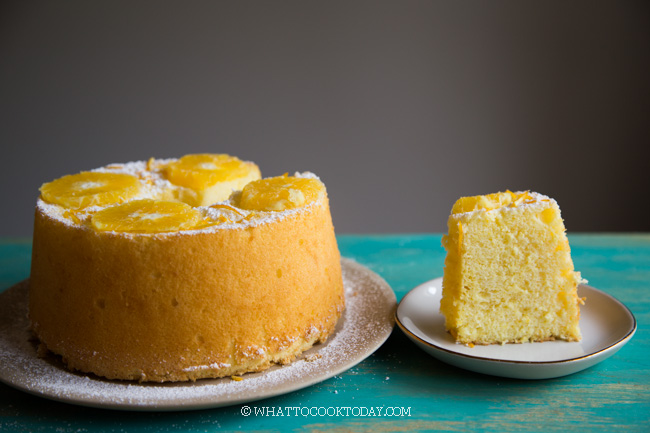
DID YOU MAKE THIS SOFT AND FLUFFY ORANGE CHIFFON CAKE RECIPE?
I love it when you guys snap a photo and tag to show me what you’ve made 🙂 Simply tag me @WhatToCookToday #WhatToCookToday on Instagram and I’ll be sure to stop by and take a peek for real!

Soft and Fluffy Orange Chiffon Cake
Ingredients
RECIPE FOR 15 cm (6 inches tube pan):
Dry ingredients:
- 50 g cake flour 1/3 cup + 2 tsp
- ⅛ tsp salt
- ¼ tsp baking powder
Wet ingredients:
- 2 egg yolks room temperature - from 58-62 grams egg with a shell
- 10 g granulated sugar 2 1/3 tsp
- 40 g orange juice 3 Tbsp
- 35 g cooking oil 7 tsp
- 1 Tbsp orange zest
Meringue:
- 2 egg whites room temperature - from 58-62 grams egg with a shell
- ¼ tsp cream of tartar
- 30 g sugar 2 1/3 tbsp
RECIPE FOR 18 cm (7 inches tube pan):
Dry ingredients:
- 75 g cake flour 1/2 cup + 1 Tbsp
- ⅛ tsp salt
- ¼ tsp baking powder
Wet ingredients:
- 3 egg yolks room temperature - from 58-62 grams egg with a shell
- 20 g granulated sugar
- 60 g orange juice 4 Tbsp
- 50 g cooking oil 3 1/2 Tbsp
- 1 ½ Tbsp orange zest
Meringue:
- 3 egg whites room temperature - from 58-62 grams egg with a shell
- ¼ tsp cream of tartar
- 45 g granulated sugar 4 Tbsp
RECIPE FOR 20 cm (8-8.5 inches tube pan):
Dry ingredients:
- 120 g cake flour 1/2 cup + 6 1/4 Tbsp
- ⅛ tsp salt
- 1 tsp baking powder
Wet ingredients:
- 5 egg yolks room temperature - from 58-62 grams egg with a shell
- 40 g granulated sugar 4 Tbsp
- 100 g orange juice 7 Tbsp
- 80 g cooking oil 5 Tbsp
- 2 Tbsp orange zest
Meringue:
- 5 egg whites room temperature - from 58-62 grams egg with a shell
- ⅓ tsp cream of tartar or use 1 tsp lemon juice or vinegar
- 60 gr granulated sugar 5 Tbsp
RECIPE FOR 23 cm (9 inches tube pan):
Dry ingredients:
- 180 g cake flour 1 cup + 5 Tbsp
- ¼ tsp salt
- 1 ¼ tsp baking powder
Wet ingredients:
- 7 egg yolks room temperature - from 58-62 grams egg with a shell
- 25 g granulated sugar 4 3/4 Tbsp
- 140 g orange juice 9 1/2 Tbsp
- 100 g cooking oil 6 Tbsp + 2 tsp
- 3 Tbsp orange zest
Meringue:
- 7 egg whites room temperature
- ½ tsp cream of tartar or use 1 1/4 tsp lemon juice or vinegar
- 120 g granulated sugar 6 3/4 Tbsp
RECIPE FOR 26 cm (10 inches tube pan)
Dry ingredients:
- 220 g cake flour 1 1/2 cups + 1 Tbsp + 1 tsp
- ¼ tsp salt
- 1 ½ tsp baking powder
Wet ingredients:
- 8 egg yolks room temperature - from 58-62 grams egg with a shell
- 35 gr granulated sugar
- 160 ml orange juice 11 Tbsp
- 130 ml cooking oil 9 Tbsp
- 3 Tbsp orange zest
Meringue:
- 8 egg whites - room temperature
- ½ tsp cream of tartar or use 1 1/2 tsp lemon juice or vinegar
- 130 g granulated sugar 8 Tbsp
To decorate the cake (optional)
- Confectioner's sugar
- Orange slices
Serving suggestions (any combination of the followings):
- Ice cream
- Whipped cream
- Fresh orange slices
Instructions
- Make sure your chiffon cake pan does not have a non-stick coating or your cake will not rise. The cake needs to cling to the side of the pan to rise tall
- Before you start making the recipe, make sure eggs and orange juice (if you keep in the fridge) are at room temperature. Get them out from the fridge 20-30 minutes and let them sit at room temperature before you plan to start working on this
Squeeze some orange juice and grate some orange zest:
- Wash the oranges with clean water and pat them dry. Use a sharp grater to grate the rind of the oranges to get some orange zest. Be careful not to grate the bitter white part. Squeeze some orange juice out to get the amount you need for the recipe
Mixing the thick batter:
- Separate the egg yolks from the whites and let them sit out for 30 minutes at room temperature. The meringue whips better at room temperature
- Mix the flour, salt, and baking powder and whisk to mix. In a separate bowl, whisk the egg yolks with sugar and cooking oil, then add orange juice and orange zest
- Gradually add the cake flour mixture to the egg batter while mixing OR if you have sieve or flour sifter, sift in the cake flour mixture into the batter, there will be no lumps when you do this, otherwise mix until smooth and no lumps, try not to overmix it too. Strain the batter if necessary to get rid of any lumps
Whipping the meringue:
- Preheat your oven to 330 F (165 C). Place the oven rack 3rd from the top, basically in the middle of the oven. For convection oven, lower the temperature by 20 F (15 C)
- Place the egg whites in a clean bowl. You will have trouble whipping your meringue if there's a trace of grease in your utensils or bowls. Beat the egg whites on medium speed until frothy, add cream of tartar or acid of choice and whip until it turns whitish. Gradually add the sugar in 3-4 batches as you beat. Beat at high speed (I used speed 6) until you get a stiff peak. You will know you get to the stiff peak when you hold your whisk up and your meringue holds its shape
Fold in meringue into the thick batter:
- Gently fold in 1/4 of the meringue into the thick batter. Using a rubber spatula, swipe from the side and gently fold over to mix and then continue. Repeat this motion several rounds. Continue on with second 1/4 of the meringue again to mix. Continue to do this until you are done with the meringue and the batter and meringue are nicely mixed
- DO NOT grease your chiffon pan. The cake needs to cling to the pan to rise. You can use a toothpick to pop any air bubbles you see and gently drop the cake pan from about 10 cm height on the counter 2-3 times. This helps to minimize shrinkage after baking
Bake the cake:
- Put the chiffon pan in the middle rack and let it bake for 40-45 minutes for 6-inch, 45-50 minutes for 7-inch, 50-55 minutes for 8 inch, 55-60 minutes for 9 inch, 60-65 minutes for 10 inch. The time is just for a reference. Your oven may need less or more time to bake
- Don't be alarmed if your cake has some cracks on top. What you are looking at will become the bottom of your cake. I find that baking at this temperature in my oven prevents the cake from cracking
Invert to cool down:
- Once out of the oven, carefully invert the pan upside down. Your chiffon pan may have the little stands for you to invert, but I find it not high enough. I use a glass jar and set the inverted pan on top of the jar and let it cool down completely. Please don't be tempted to remove from the pan if it's still warm. It takes about one to two hours to cool down completely
- Once it's cool down completely, use a spatula knife to run through the edge of the cake to help release the cake. Gently push the base of the pan down. Use the knife again to run through the top of the cake to help release it from the base of the pan
For simple decoration on the cake (optional):
- Arrange some thinly sliced oranges. Dust with some confectioners sugar and serve
Marv's Recipe Notes
For 26 cm tube size recipe: To make 220 gr cake flour, use 175 gr all-purpose flour + 45 gr cornstarch.

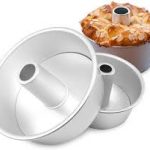

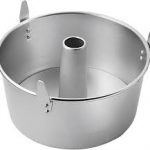
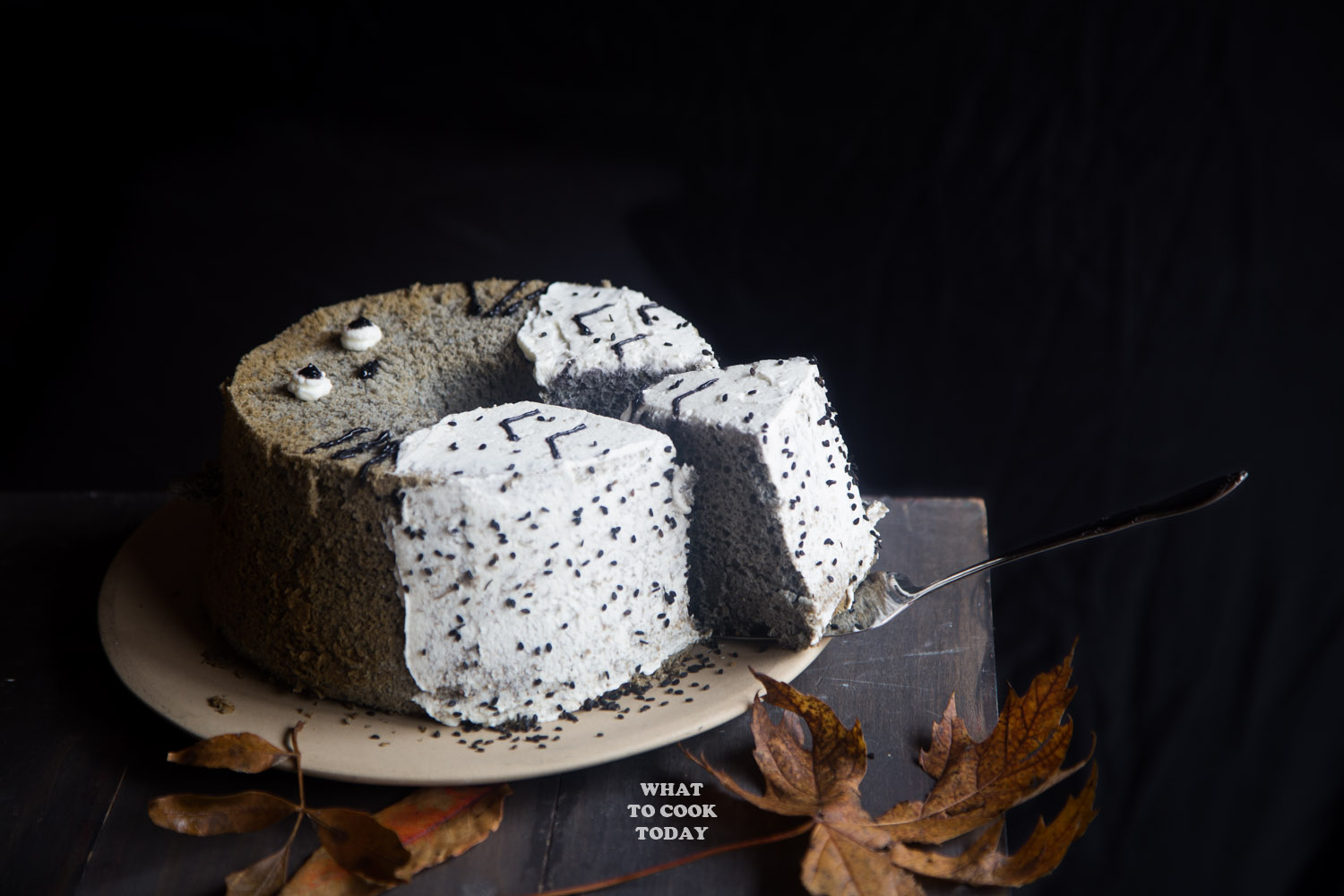
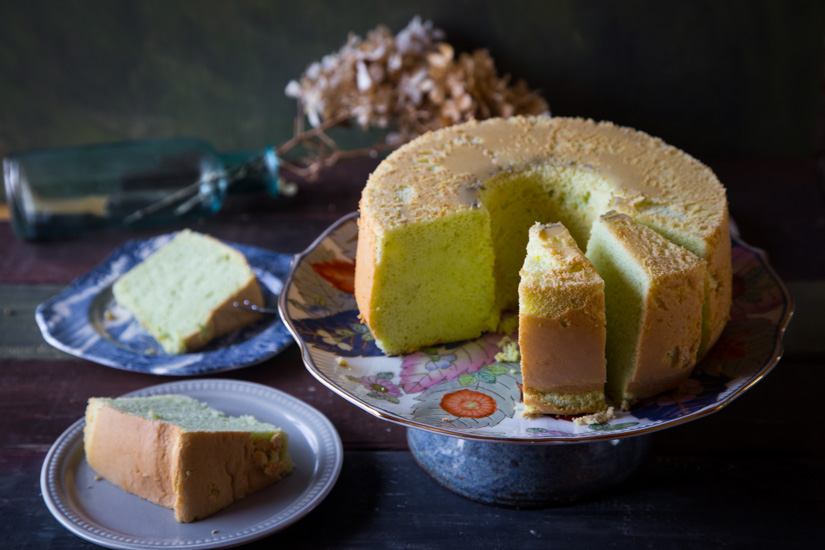

17 comments
This recipe is amazing! I have made the cake a few times and everyone loves it! Thankyou so much for sharing!
Hi Belinda, I couldn’t be happier to read this 🙂 So glad the recipe works for you!
Wow it’s easy and I made it too !! Thank you for sharing your recipe 😍